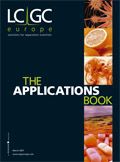Accelerated Buffer System for Amino Acid Analysis
The Application Notebook
The continual increase in sample numbers in busy labs means that it is often difficult for quality control or contract analysis labs to maintain short turnaround times, particularly when instruments are already running at full capacity. To address the need for faster analysis while retaining the quality of separation offered by dedicated amino acid analysers, an improved formulation of sodium citrate based buffers has been developed by Biochrom.
The continual increase in sample numbers in busy labs means that it is often difficult for quality control or contract analysis labs to maintain short turnaround times, particularly when instruments are already running at full capacity. To address the need for faster analysis while retaining the quality of separation offered by dedicated amino acid analysers, an improved formulation of sodium citrate based buffers has been developed by Biochrom.
Instrumentation
The Biochrom 30 amino acid analyser is a compact bench top, PC-controlled liquid chromatography system for the specific analysis of amino acids for the pharmaceutical, proteomics, food and feedstuffs industries.
Amino acids are separated by ion exchange chromatography and quantified using dual wavelength photometric detection following ninhydrin post column derivatization, as required by the AOAC method and the Commission Directive 98/64/EC. Because of the quality of the separation, high reproducibility of retention time and peak area, and the extensive stability of calibration, dedicated amino acid analysis has become the standard method for amino acid analysis of feeds.
Experimental conditions
The accelerated buffer system consists of a set of four buffers, with pH varying between 3.2 and 9.2, and a sodium hydroxide regeneration solution.
The accelerated buffer system is compatible with all Biochrom sodium cation exchange columns and can, therefore, be used on the Biochrom 32 oxidized protein system as well as on the Biochrom 31 protein system, with no modification of the experimental conditions except for the analytical programme. The programme was specifically developed to achieve optimum separation with the accelerated buffer system using buffer and ninhydrin flow-rates of 35 mL/hr and 25 mL/hr respectively.

Figure 1
Results
As shown on the standard chromatogram (Figure 1), using this improved buffer system, arginine elutes at around 45 min compared to 60 min for the original oxidized high performance system. The quality of the separation remains excellent with percentages of separation exceeding 95% for most amino acids commonly found in foods and feeds.
The system also offers more flexibility for the analysis of other amino acids of interest such as taurine, 2,6-diaminopimelic acid, β-alanine, glucosamine, galactosamine and hydroxylysine. The complete separation of 30 amino acids is achieved in less than 50 min.
Conclusion
The accelerated buffer system enables the total analysis time for a full amino acid profile to be reduced by up to 30%, which is equivalent to seven additional runs per day. By reducing the run times, the buffer and ninhydrin consumptions are also reduced. For the analysis of specific amino acids such as lysine, short programmes are also available.
The accelerated buffer system is, therefore, an attractive alternative to the classic oxidized system, particularly for laboratories for which speed of analysis is critical.
Aurélie Lolia, Biochrom Ltd, Cambridge, East Anglia, UK.
References
1. J. Fontaine, CAB International, Amino Acids in Animal Nutrition (2), (2003)
2. M. Davies, The Biochrom Handbook of Amino Acids.
3. Lolia, Bee and Jomah, LCGC N. Am., Application notebook, (2004)
For a copy of the Biochrom "Amino Acid Analysis of Food and Feedstuffs" brochure, please contact support@biochrom.co.uk

Biochrom Ltd
Cambridge Science Park, Milton Road,
Cambridge CB4 0FJ, UK
Website: www.biochrom.co.uk
Analytical Challenges in Measuring Migration from Food Contact Materials
November 2nd 2015Food contact materials contain low molecular weight additives and processing aids which can migrate into foods leading to trace levels of contamination. Food safety is ensured through regulations, comprising compositional controls and migration limits, which present a significant analytical challenge to the food industry to ensure compliance and demonstrate due diligence. Of the various analytical approaches, LC-MS/MS has proved to be an essential tool in monitoring migration of target compounds into foods, and more sophisticated approaches such as LC-high resolution MS (Orbitrap) are being increasingly used for untargeted analysis to monitor non-intentionally added substances. This podcast will provide an overview to this area, illustrated with various applications showing current approaches being employed.
New Method Explored for the Detection of CECs in Crops Irrigated with Contaminated Water
April 30th 2025This new study presents a validated QuEChERS–LC-MS/MS method for detecting eight persistent, mobile, and toxic substances in escarole, tomatoes, and tomato leaves irrigated with contaminated water.
University of Tasmania Researchers Explore Haloacetic Acid Determiniation in Water with capLC–MS
April 29th 2025Haloacetic acid detection has become important when analyzing drinking and swimming pool water. University of Tasmania researchers have begun applying capillary liquid chromatography as a means of detecting these substances.
Prioritizing Non-Target Screening in LC–HRMS Environmental Sample Analysis
April 28th 2025When analyzing samples using liquid chromatography–high-resolution mass spectrometry, there are various ways the processes can be improved. Researchers created new methods for prioritizing these strategies.

.png&w=3840&q=75)

.png&w=3840&q=75)



.png&w=3840&q=75)



.png&w=3840&q=75)








